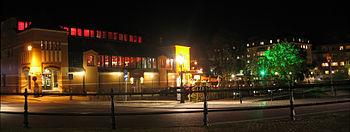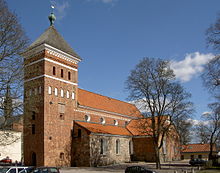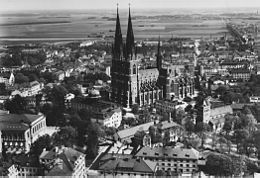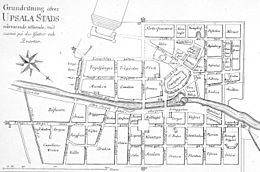Uppsala
![]()
The title of this article is ambiguous. For other meanings, see Uppsala (disambiguation).
Uppsala [ˈɵpːˌsɑːla] ![]() , obsolete also Upsala, is a major city in the Swedish province of Uppsala län and the historical province of Uppland. Uppsala is the county seat and the capital of the municipality of the same name.
, obsolete also Upsala, is a major city in the Swedish province of Uppsala län and the historical province of Uppland. Uppsala is the county seat and the capital of the municipality of the same name.
The city is the fourth largest in the country by population after Stockholm, Gothenburg and Malmö and is divided into seven boroughs.
Uppsala is a traditional and well-known university town. Uppsala University was founded in 1477, making it the second oldest university in Scandinavia after the Studium generale of 1425 in Lund, Denmark at the time. The city is the seat of the Archbishop as well as the Bishop of the Uppsala Diocese of the Church of Sweden.

City centre with the Saluhallen market hall
Geography
Uppsala is located about 72 km north of Stockholm and about 37 km from Arlanda Airport. The river Fyrisån runs through the town and flows into Lake Mälaren 8 km further south. Uppsala lies partly at the foot of and partly on a scree ridge called Uppsalaåsen, which dates from the last ice age and stretches 500 km from Härjedalen to the Södertörn peninsula south of Stockholm.
History
Beginnings until 13th century
The place where Uppsala is located today was originally named Aros and later Östra Aros, so as not to be confused with Västra Aros, now Västerås. The name Aros means river mouth and is composed of the Old Swedish genitive form of a for river and os for mouth. It referred to what was then the mouth of the Fyrisån River in the fjord, which provided a connection to the Baltic Sea during the Viking Age. Due to land uplift and increasing siltation, the fjord was slowly drained. Early records mention a harbour at the mouth of the fjord. Travellers moored their boats here to continue their journey overland to Uppsala, today's Gamla Uppsala ("Old Uppsala"), five kilometres away. The hoard of Söderby dates from this early period.
When the local pagan centre with the presumed temple of Uppsala no longer existed, the importance of the city as the most important Ting and market place as well as royal seat declined and Christianity prevailed in Uppland, Old Uppsala became the bishop's seat. However, Östra Aros remained an important port for trade in Uppland but also as far as Norrland. At the beginning of the 13th century, Old Uppsala had lost so much of its importance that in 1215/16 there were already first considerations to move the archbishop's seat and the cathedral church to Sigtuna, which had already been the bishop's seat since the 12th century. However, the considerations were not put into practice, but were not taken further until around 1240, when a cathedral chapter was established. Finally, in 1258, Pope Alexander IV granted permission for the move to Östra Aros on the condition that the cathedral church should retain its name.
Whether the church of St. Per already existed in what is now Uppsala at this time is not proven with certainty, as its first written mention did not occur until 1302 in a will. On the other hand, the Holy Trinity Church (Helga Trefaldighets kyrka) - first mentioned in 1221 - was already on the west side of the river, as well as the Church of Our Lady (Vårfrukyrkan) a little further south of St. Per on the east side of the river. The Trinity Church was then already the meeting place for the rural community there. Otherwise, the western side was rather sparsely built-up when the move of the bishop's seat took place in 1273. Shortly thereafter, the name Uppsala began to be used instead of Östra Aros. After the move, not only the servants of the church provided a boom, but also pilgrims and other travellers who arrived for the great ecclesiastical festivals.
14th/15th century
During the Middle Ages, but also as early as the time of Magnus Ladulås, German craftsmen and merchants settled in Uppsala. Legally, the city differed from the surrounding countryside in that it had already been granted city rights before 1302. In that year there was the first report of a bailiff and a town council. From the same period there are also reports that the town was at least partially surrounded by a moat and that the two previously named churches, St. Pers Church and Heliga Trefaldighets Church, certainly existed.
The royal domain "Islandet" (Swedish: Kungsgården "Islandet") was first mentioned in 1338. It served primarily as the residence of the bailiff, but was also used as the king's residence during his stays in Uppsala. Duke Karl still lived there in 1594, before he gave the estate to the governor Kristofer Wärnstedt in 1610. The bishop's seat at that time was located where the university is today and was built around 1340. The school belonging to the cathedral was located on an island in the Fyrisån, Studentholmen (Swedish for student island). In 1477 Archbishop Jakob Ulfsson obtained permission from the Pope to establish a "studium generale", or university. This makes it the second, and oldest, university in Scandinavia still in existence, and at the beginning it was still located in the rooms of the cathedral school.
In the Middle Ages, it was its status as a bishop's seat that shaped Uppsala's development. As a coronation site and place for important meetings (Swedish: herredagar), it was also seen as the actual capital of Sweden during this period. During the time of the Kalmar Union, the town was the scene of disputes on several occasions. During the disputes, the cathedral church was stormed in 1470 and the royal domain was burned down in 1501. Uppsala was also reduced to rubble by fires on several occasions. The most devastating fire occurred in 1473, when the cathedral church and several large buildings were damaged.
16th-18th century
During the war of liberation under Gustav I Wasa, the bishop's seat was set on fire in 1521. The Reformation and the loss of influence of the church changed the circumstances. The two aforementioned churches slowly fell into disrepair. The monastery and much of the other church property were confiscated by the crown. The attached school was discontinued altogether. As a result of this, and the loss of the church's generous commissions, there was an economic decline. The population decreased. However, the king held on to Uppsala and regularly visited the city together with his court, so that the decline was cushioned. With the start of construction of Uppsala Castle in 1547, the economic situation began to improve again. The construction work attracted many workers to the city, and the hope of a permanent royal residence made Uppsala a centre of attraction.
The economic recovery continued during the reigns of Erik XIV and Johan III. The latter, however, moved the university, which was almost closed, to Stockholm. However, the relocation had little effect on the development of the city. Uppsala was more severely affected by the fire of 1572, but Johan III made every effort to ensure that the city recovered quickly. It continued to be the place of coronation and the site of great meetings (Swedish herredagar). The most important meeting took place in 1593 as the Synod of Uppsala (Uppsala möte), when ecclesiastical conditions were reorganized and the city regained its university. Since the college in Stockholm was no longer continued, there was no longer any competition between the two cities. Through donations from Gustav II Adolf, the university was provided with sufficient financial resources and was able to ensure its continued existence. In the Middle Ages, the church had been the driving force behind Uppsala's development; now the university was to take over this role.
In the 17th century Olof Rudbeck the Elder promoted the good development of Uppsala. He worked to ensure that the university could develop to its best in a good environment. His efforts were set back by a major fire that broke out on the night of 15-16 May 1702. The fire devastated almost the entire city. The cathedral church, the castle and most of the university buildings, with the exception of the Gustavianum, were damaged. Not only the material damage was enormous, but also cultural values fell victim to the flames. It took decades for the city to recover.
19th century to present
When the town had slowly recovered, the Kungsängen district and part of Fjärdingen were devastated again in 1766. The undestroyed part of Fjärdingen went up in flames in 1809. After a moderate growth in the following period, things did not improve until the inauguration of the railway line from Stockholm to Uppsala. The transfer of the artillery regiment from Uppland to Uppsala gave the town further impetus for growth, so that in 1888 it had 21,249 inhabitants.
The spelling of the city name was changed from Upsala to Uppsala around 1903.

Drawing of the fire of 1702

The Trinity Church today, in the background on the left a part of the cathedral church

Old town of Uppsala with university and cathedral (aerial view from 1940)

City map from 1770
Search within the encyclopedia